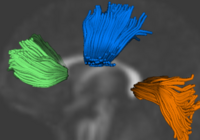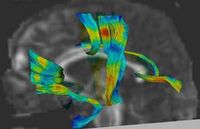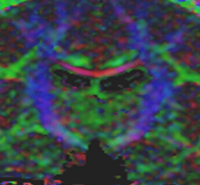Algorithm:Utah2
Back to NA-MIC Algorithms
Overview of Utah 2 Algorithms
At Utah, we are interested in a range of algorithms and solutions for the analysis of DTI and the segmentation of lupus lesions.
Utah 2 Projects

|
Population Analysis from Deformable RegistrationAnalysis of populations of diffusion images typically requires time-consuming manual segmentation of structures of interest to obtain correspondance for statistics. This project uses non-rigid registration of DTI images to produce a common coordinate system for hypothesis testing of diffusion properties. More... New: Command line DTI tools available as part of UNC NeuroLib |

|
Quantitative Analysis of Fiber Tract BundlesDT-MRI tractography can be used as a coordinate system for computing statistics of diffusion tensor data. The quantitative analysis of diffusion tensors takes into account the space of tensor measurements using a nonlinear Riemannian symmetric space framework. Tracts of interest are represented as a medial spline attributed with cross-sectional statistics. More... New: Gilmore J, Lin W, Corouge I, Vetsa Y, Smith J, Kang C, Gu H, Hamer R, Lieberman J, Gerig G. Early Postnatal Development of Corpus Callosum and Corticospinal White Matter Assessed with Quantitative Tractography. AJNR Am J Neuroradiol. 2007. |

|
Influence of Imaging Noise on DTI StatisticsClinical acquisition of diffusion weighted images with high signal to noise ratio remains a challenge. The goal of this project is to understand the impact of MR noise on quantiative statistics of diffusion properties such as anisotropy measures, trace, etc. More... New: Casey Goodlett, P. Thomas Fletcher, Weili Lin, Guido Gerig. Quantification of measurement error in DTI: Theoretical predictions and validation, MICCAI 2007. |